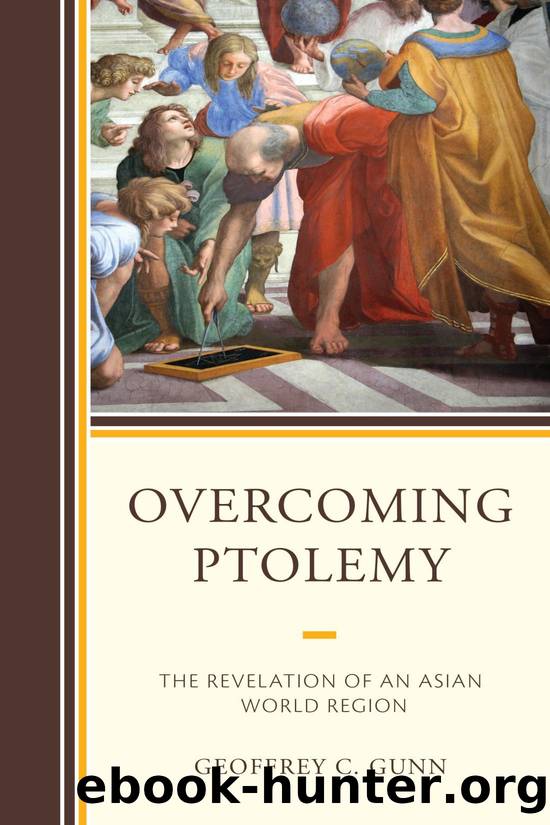Overcoming Ptolemy by Geoffrey C. Gunn

Author:Geoffrey C. Gunn
Language: eng
Format: epub
ISBN: 9781498590143
Publisher: Lexington Books, a division of Rowman & Littlefield Publishers, Inc.
Figure 5.1 Asia: With the Islands Adioyning Described, the Atire of the People, & Townes of Importance, all of them Newly Augmented. John Speed (1626). Published in A Prospect of the Most Famous Parts of the World (London, 1662). City maps in upper border: Candy—Goa—Damascus—Jerusalem—Ormus—Bantam—Aden—Macao. Scale [ca. 1:27,000,000] at Equator. Impressive with its longitude and latitude grid, here Speed creates his own world regional delineation of Asia with boundaries imposed. China is named, as is Tartaria, West Ocean, East Ocean, and Chinean Ocean. The American continent is acknowledged. Source: Map reproduction courtesy of the Norman B. Leventhal Map & Education Center at the Boston Public Library.
Tartaria, in turn, was divided into five main subregions (with additions), Tartaria Preompensis (Tartaria Minor, wholly in Europe); Tartaria Deserta (Asiatica); Antiqua; Zagathay (Sythia intra montem Imaum of the ancients); Turkestan, and Cathay (seat of the Great Cham with his court in Cambalu [Khanbalik]). Additionally, he expounds upon Serica and Synthia extra montem, “in which I follow not the bounds laid down by Ptolemy, who for want of that knowledge in these remote countries which these later ages have afforded, if fain to shut it up on the north and east with Terra Incognita.” In other words, Heylyn presumes to know more about these eastern and northerly zones than the ancients. “At the present it is called Cathay.” As for Serica/Sera/ Silk, he offers no advance on Pliny, fictionalizing a race of people said to live to up to 200 years of age. But Ptolemy locates this place too far north, he asserts. This excursion on Tartary is important as the issue came to beset Czarist Russia and the Qing dynasty at a point in history when both expanding empires came into collision over ill-defined boundaries or, actually tracts of steppe virtually unowned apart from nomadic inhabitants.
Cathay or China
On Cathay and China, as Heylyn continues, by contrast with Tartaria:
China is bounded on the North, with Cathay, and the eastern Tartars, from which separated by a continuous chain of hills . . . and where that chain is broken off, or interrupted, by a great wall extended 400 leagues in length, on the South partly with Cochinchina, a province of India, partly with the Ocean, on the East with the Oriental Ocean; and on the West with part of India, and of Cathay. (Heylyn 1682: 181)
As he continue, with allusion to the name of China:
The Ancient inhabitants of Sine, in the time of Ptolemy, were towards the North. . . . United into one body by the name of Sina, and known by that name to the Romans, in the time of Ptolemy who bounded them on the north with Serica, on the west with India extra Gangem, and on the East and South with Terra incognita; which though it makes up the least part of modern China, Serica touching only a corner of the Northwest of it, and the main Ocean washing it on the East and South. (Heylyn 1682: 187)
He does allow, however, that the Arabs and (modern) Latin authors do reveal the dimensions of this “mighty kingdom.
Download
This site does not store any files on its server. We only index and link to content provided by other sites. Please contact the content providers to delete copyright contents if any and email us, we'll remove relevant links or contents immediately.
The Secret History by Donna Tartt(16611)
Red Sparrow by Jason Matthews(4654)
Harry Potter 02 & The Chamber Of Secrets (Illustrated) by J.K. Rowling(3289)
In a Sunburned Country by Bill Bryson(2941)
Figure Drawing for Artists by Steve Huston(2792)
The Daily Stoic by Holiday Ryan & Hanselman Stephen(2703)
Drawing Cutting Edge Anatomy by Christopher Hart(2672)
The Roots of Romanticism (Second Edition) by Berlin Isaiah Hardy Henry Gray John(2565)
Japanese Design by Patricia J. Graham(2552)
Make Comics Like the Pros by Greg Pak(2421)
Stacked Decks by The Rotenberg Collection(2267)
Harry Potter and the Deathly Hallows (7) by J.K. Rowling(2213)
On Photography by Susan Sontag(2128)
Draw-A-Saurus by James Silvani(2102)
Tattoo Art by Doralba Picerno(2080)
Foreign Devils on the Silk Road: The Search for the Lost Treasures of Central Asia by Peter Hopkirk(2053)
The Traveler's Gift by Andy Andrews(2008)
Churchill by Paul Johnson(2006)
Drawing and Painting Birds by Tim Wootton(1997)
